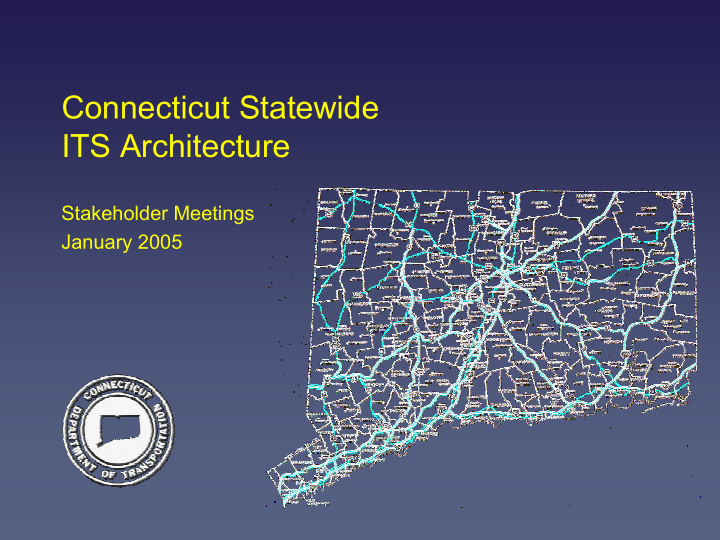



Connecticut Statewide ITS Architecture Stakeholder Meetings January 2005
Goals Of this project: Of this meeting: • Develop a Statewide ITS • Introduce the project Architecture for Connecticut – Conformance with the National ITS • Collect information Architecture and Standards – ITS in the region (existing and – Satisfy Federal requirements for planned) Regional ITS Architecture – Regional needs development • Facilitate interagency coordination – Necessary for effective delivery of ITS services 2
Presentation Outline • ITS Architecture Background – Federal Requirements – Relevance and Benefits • Statewide Architecture Project – Approach – Involvement Plan 3
ITS Architecture Background
ITS Architecture Definition • National ITS Architecture • Regional ITS Architecture – A general framework for planning, – A specific regional framework for defining, and integrating ITS ensuring institutional agreement and technical integration for the – Defines the component systems and implementation of ITS projects in a their interconnections and particular region information exchanges 5
Federal Requirements • All ITS projects funded through the Highway Trust Fund (in whole or in part) must conform with the National ITS Architecture and applicable standards. • FHWA Rule and FTA Policy: – Conformance with the National ITS Architecture defined as the use of the National ITS Architecture to develop a Regional ITS Architecture. – Regions with ITS projects (as of 2001) must develop a Regional ITS Architecture by April 8, 2005. 6
Benefits of a Regional ITS Architecture • Access to Federal Funding • Cost Savings – Coordination of capital investment among agencies leads to lower overall costs – Adherence to standards leads to long-term maintenance cost savings – Future system upgrades and expansion facilitated by use of standards 7
Benefits of a Regional ITS Architecture (cont’d.) • Improved Interagency Coordination – Communication facilitated in architecture development process – Operational concept established – Necessary agreements identified • Better Services to Public – Consistency across jurisdictional boundaries – Examples: • VMS messages • Travel information websites • Electronic fare collection 8
Statewide ITS Architecture Project
Study Area Initial scope: Greater Hartford Current scope: Statewide 10
Previous and Ongoing Studies • Intelligent Transportation Systems "ITS”: A Strategic Plan for the Capitol Region (1997) • ConnDOT ITS Implementation Plan (June 1999) • ITS Strategic Deployment Plan for the New Haven-Meriden Metropolitan Area (1999) • Greater Bridgeport Regional ITS Study and Concept Design (June 2001) • ITS Strategic Deployment Plan: Southeast Connecticut (Dec. 2002) • Hartford Area Regional ITS Architecture (2004) • Regional ITS Architecture/Advanced Concept Plan for Greater Bridgeport Planning Region (ongoing) • Intelligent Transportation Systems Plan: South Western Region (ongoing) 11
Architecture Development Approach • Previous studies to be used as starting point – Updating based on current deployment and needs assessment • Top-down approach to development: Needs • Stakeholder participation Functional essential for: Requirements – Identification of needs – Identification of existing Systems and systems to integrate Technologies – Interagency coordination • The end result is only as good as the input received! 12
Expected Outcome of Project • ITS Architecture – Updated documentation of needs, inventory, etc. – Interactive website • Implementation Plan – Deployment-oriented approach – Recommendations for ITS initiatives 13
14
15
16
Project Tasks 1. Data Collection & Stakeholder Identification • Stakeholder Involvement Plan • ITS Inventory • Compilation of Needs/Functional Requirements 2. Definition of ITS Interfaces • Architecture Development Workshop • Regional ITS Architecture Website 3. Implementation of ITS Projects • Implementation Plan • Operational Considerations 4. Development of ITS Architecture Document 17
Participants • Core Project Team: – Connecticut Department of Transportation – Federal Highway Administration / Federal Transit Authority – Regional Planning Organizations • Other Stakeholders: – Transit Operators – Municipalities • Public Works • Fire/Police – CT Department of Public Safety 18
Stakeholder Involvement • Initial Individual Meetings – Provide background on project – Develop ITS inventory – Obtain information on needs, current activities, and planned projects • Architecture Development Workshop – Obtain input on architecture elements and interfaces – Includes follow-up review of Draft Architecture Website • Review Meeting for Draft Architecture – Presentation of draft Final Report 19
Schedule 2004 2005 Oct Nov Dec Jan Feb Mar Apr Data Collection & Stakeholder Identification Initial Meetings Definition of ITS Interfaces Architecture Workshop (2/7/05) Implementation of ITS Projects Development of ITS Architecture Document Review Meeting 20
Questions for Discussion 1. What ITS elements have been implemented by your agency/organization? 2. Which of your upcoming or planned projects have ITS components? 3. With what other organizations do you share data/information? 4. What information from other organizations would be valuable for your operations? 5. What are your organization’s current investment priorities (not necessarily ITS-related)? 6. What are the key issues or concerns that your organization is currently facing? 21
Contact Information • ConnDOT: • FHWA: – Hal Decker: (860) 594-3431 – Bob Ramirez: (860) 659-6703 x3004 harold.decker@po.state.ct.us robert.ramirez@fhwa.dot.gov – Bob Kennedy: (860) 594-3458 robert.kennedy@po.state.ct.us • IBI Group: – Angus Davol: (617) 450-0701 adavol@ibigroup.com 22
Recommend
More recommend